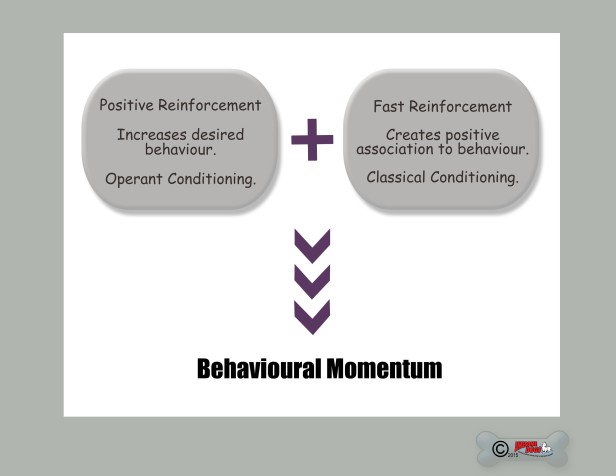Barks Blog
Reaching the Holy Grail of Training
Years ago, I taught our Kiki a formal recall using targeting. Systematically I proceeded to work through the exercise. Much to my delight, Kiki developed the most fantastic competition recall. People gasped at her speed and enthusiasm. Her formal recall never failed us over the years. You could say that it had behavioural momentum.
Domjan, in The Principles of Learning and Behavior describes behavioural momentum as, “response persistence in extinction.” In non-technical language, behaviours with momentum are enthusiastic, despite distractions. They are highly resistant to extinction. Behavioural momentum is the Holy Grail of dog training.
Behaviours with momentum are like boulders rolling down a hill. Considerable effort is required to stop them. By contrast, weak behaviours are like pebbles. The slightest bump in the road and they get derailed.
Sluggish responses are an indication of poor behavioural momentum. Dogs that are easily distracted have poor momentum. When sniffing a blade of grass is more appealing than coming when called, recall behavioural momentum is low. If you wonder if your dog enjoys doing what you ask, then you might have a behavioural momentum issue.
When owners ask for reliable manners, they are asking for behaviour momentum. They want a dog that walks politely and ignores squirrels. They want a dog that keeps four paws on the ground, even when visitors approach. They want fast, immediate recalls.
People want solid, reliable, strong behaviours they can count on. There is no magic. Behavioural momentum combines operant and classical conditioning. Pavlov might always be on your shoulder. For too many, he’s snoozing, periodically waking to create an unexpected association here or there. We forget about him and he dozes off again. Wake him up. Intentionally create behavioural momentum by using a fast rate of reinforcement.
“Behavioral momentum is directly related to the rate of reinforcement (see Nevin & Grace, 2000). A higher rate of reinforcement produces behavior that has greater momentum and is less susceptible to disruption.” The principles of learning and behavior – Domjan
Crazy fast reinforcement triggers two types of learning. The dog learns the skill through positive reinforcement. The fast reinforcement creates a positive association to the behaviour. When dogs love executing learned skills, distractions are less tempting. That is crazy powerful stuff.
Food is a natural fit for creating momentum. Food offers ease of use, speed of delivery and speed of consumption. Anything that slows the rate of reinforcement can interfere with creating momentum. Slow reinforcement leads to frustration, boredom and wanderitis. It is the road to “I’d rather be doing something else.”
How fast is fast? The following video shows my Karma working with a high speed of reinforcement. A reasonable goal for initial training is ten reinforcements per minute (or about a third of the reps in the video.) Reinforcements should come quickly enough that the space between repetitions is devoid of wanderitis.
Slow reinforcement tanks momentum. The temptation to prove that we can quickly wean away from “treats” can lead to slow reinforcements. We employ a litany of protocols, “real life” reinforcements, games, variable reinforcement schedules and Premack. While there is nothing wrong with some of these things some of the time, they are slow reinforcements.
Sluggish, sloppy outcomes tied to poor momentum convince people that positive reinforcement is not reliable or effective. There’s a real tragic irony in there. Tactics that we use to convince people to use positive reinforcement may slow reinforcement, sabotaging reliability and enthusiasm. Weak results convince people that positive reinforcement did not work well enough. Aversives can trickle back into the dog’s training.
Behavioural momentum is within anyone’s reach. Both are possible when operant and classical conditioning neatly combine. Enthusiastic, persistent responses tell us there is no place the dog would rather be. There is no behaviour they’d rather be doing. If we say, “sit,” the dog responses with “I thought you’d never ask.”
Creating behavioural momentum is the trainer’s choice to use food to its full potential. We can choose to decide, today, that we will not only teach behaviours, we will teach so the dog loves doing them. We owe the dogs that. If we create behavioural momentum, there will be no doubt in our mind that the dog wants to do the things we ask of them.
There is no greater feeling than knowing you have reliable behaviour from a happy dog. It really is a Holy Grail worth pursuing. Wake Pavlov up and get him to work. He is not just a tag-a-long.
About the Author
Yvette Van Veen PCT-A is dog behavior consultant and owner of Awesome Dogs, in Dorchester, Ontario, Canada. She is also a long-time columnist and multiple Dog Writers Association of America award nominee, and currently writes a regular column for The Toronto Star. She has worked with rescue dogs for more than 14 years, focusing mainly on rural, roaming and feral rescue dogs from communities throughout Ontario and Quebec, Canada. She is also the creator of Awesome Dogs Shareables, an educational meme site providing resources and training tips in small, shareable formats.

